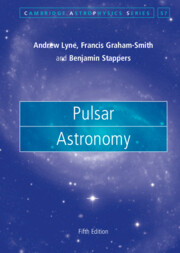Book contents
- Frontmatter
- Contents
- Preface
- Part I Discoveries and Techniques
- 1 The Discoveries
- 2 Telescope Techniques, Radio to TeV
- 3 Receiver Techniques and Data Analysis
- 4 Surveys and Population
- 5 Pulsar Timing
- 6 Timing and Astrometry of Binary Pulsars
- 7 The Distances of the Pulsars
- Part II Observed Physical Characteristics
- Part III Neutron Star Physics
- Part IV Environments and the Interstellar Medium
- References
- Index
5 - Pulsar Timing
from Part I - Discoveries and Techniques
Published online by Cambridge University Press: 21 July 2022
- Frontmatter
- Contents
- Preface
- Part I Discoveries and Techniques
- 1 The Discoveries
- 2 Telescope Techniques, Radio to TeV
- 3 Receiver Techniques and Data Analysis
- 4 Surveys and Population
- 5 Pulsar Timing
- 6 Timing and Astrometry of Binary Pulsars
- 7 The Distances of the Pulsars
- Part II Observed Physical Characteristics
- Part III Neutron Star Physics
- Part IV Environments and the Interstellar Medium
- References
- Index
Summary
Precision timing of pulses is at the heart of pulsar research. Pulse arrival times can be measured to an accuracy of only a few metres travel time, and analysis must take account of pulsar positions and the Earth’s orbit, the Römer correction to the barycentre, and General Relativistic corrections. Pulsar timing contributes to the comparison of fundamental positional reference frames. Timing provides periods and period changes on short and long time scales, giving pulsar ages and proper motions. The precision timing of some millisecond pulsars is comparable to the best terrestrial laboratory clocks.
Keywords
- Type
- Chapter
- Information
- Pulsar Astronomy , pp. 73 - 89Publisher: Cambridge University PressPrint publication year: 2022

